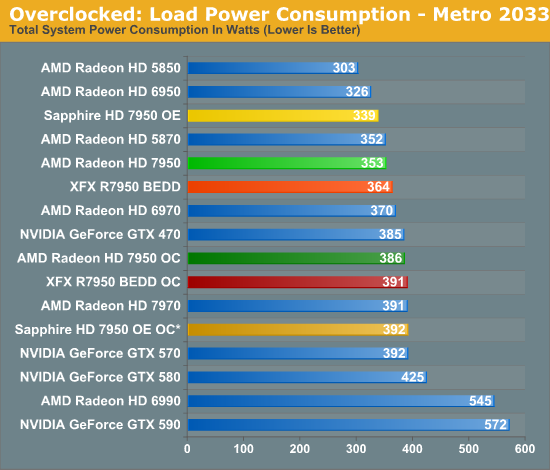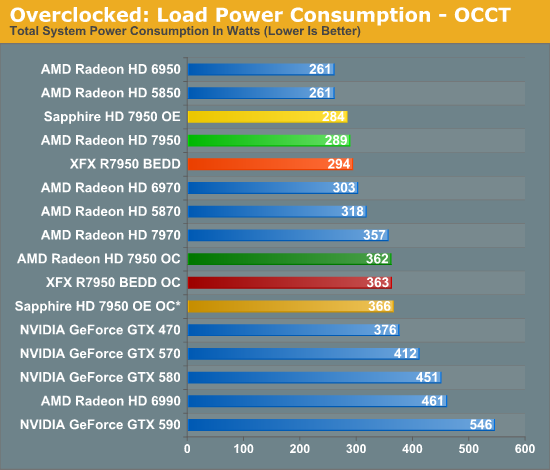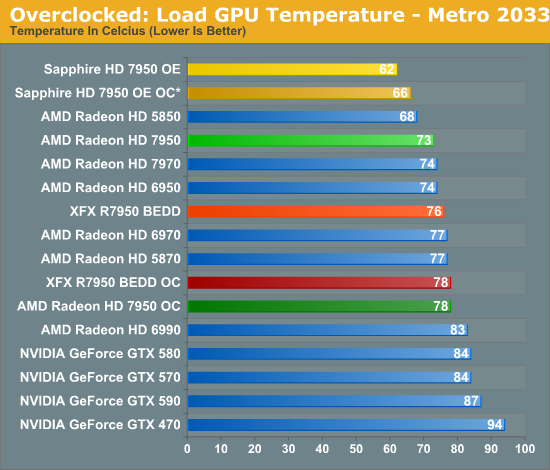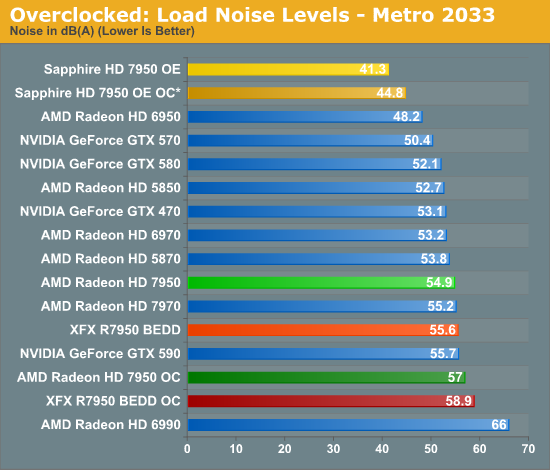AMD Radeon HD 7950 Review Feat. Sapphire & XFX: Sewing Up The High-End Market
by Ryan Smith on January 31, 2012 9:02 AM ESTOverclocking: Power, Temp, & Noise
In their marketing materials AMD is heavily pushing overclocking, and they have good reason to. With the 7970 we’ve established that Tahiti has quite a bit of overclocking headroom, and as the 7950 is clocked lower by default this opens up that headroom even further. Realistically AMD’s binning process means that the best clocking Tahiti GPUs are going to be allocated to the 7970 unless they have failed shaders, but even with that there’s quite a bit of potential on paper.
As with overclocking the 7970, our goal overclocking the 7950 is to see how much you can get for free; that is without any voltage adjustments. AMD’s reference PCBs are not particularly overbuilt for overclocking—cards like that will come later—so sticking to the reference voltage is the safest option, not to mention the easiest. With the 7970 we were able to get 200MHz (22%) overclocks without any voltage adjustment, and we’re hoping for the same out of the 7950.
With that said, we quickly ran into a wall on one card: the Sapphire 7950. Sapphire’s low VID of 0.993v may be great for temperature and noise at stock, but it’s not doing overclocking any favors. We only hit 950MHz at that voltage. As the Sapphire was the odd man out—every other card was at 1.093v—we did end up overvolting the Sapphire to 1.093v to see what it was capable of when put on similar footing as the rest of our cards.
After bringing up the voltage of our Sapphire card, all of our 7950s ended up overclocking to very similar levels. Our Sapphire and AMD cards topped out at 1025MHz core, a 225MHz (28%) overclock over a stock 7950 and a 125MHz (14%) overclock over the Sapphire’s factory overclock, while our XFX card reached 1050MHz, a 150MHz (17%) overclock beyond XFX’s factory overclock. Meanwhile the memory clocks on all of our cards topped out at 5.8GHz, beyond which we’d start seeing performance regressions from error correction on the memory bus.
| Radeon HD 7950 Overclocking | |||||
| AMD Radeon HD 7950 | Sapphire HD 7950 Overclock Edition | XFX R7950 BEDD | |||
| Shipping Core Clock | 800MHz | 900MHz | 900MHz | ||
| Shipping Memory Clock | 5GHz | 5GHz | 5.5GHz | ||
| Shipping Voltage | 1.093v | 0.993v | 1.093v | ||
| Overclock Core Clock | 1025MHz | 1025MHz | 1050MHz | ||
| Overclock Memory Clock | 5.8GHz | 5.8GHz | 5.8GHz | ||
| Overclock Voltage | 1.093v | 1.093v | 1.093v | ||
As you can imagine, with such similar overclocks, gaming performance on all 4 cards ended up being very similar. So we’ll get to gaming performance in a minute, while we’ll start with power, temperature, & noise.


Even though we’re not increasing the voltage on our AMD and XFX cards, merely overclocking them and raising the PowerTune limit to avoid throttling does drive the power consumption up. As is typical with heavily overclocked cards, overclocking quickly drives up power consumption and the 7950s are no exception. After overclocking power consumption is almost identical to the stock 7970, so while you can get 7970 performance you still need to pay the price with 7970 power consumption. Meanwhile it’s interesting to note that even with the extra 0.1v we’ve given the Sapphire card its final power consumption is only ever so slightly higher than the other 7950s, proving that voltage is the great equalizer in this case.


With the increase in power comes an increase in temperatures. The Sapphire card still does very well here staying in the low 70s even under OCCT, while the reference and XFX cards hit the high 70s under Metro and mid 80s under OCCT. As we’ve yet to really ascertain what the thermal limits are for Tahiti, it’s not clear whether there’s too much thermal headroom left for the GPU, particularly under OCCT.


Last but not least we have load noise. The Sapphire card is once more a stellar performer, and we still can’t get it above 50dB even with OCCT. Unfortunately the XFX 7950 BEDD has its biggest fallout yet—it may be able to overclock well, but at 64dB under OCCT the performance isn’t going to be worth the immense amount of noise it creates to move enough air to keep the GPU cool.










259 Comments
View All Comments
mczak - Tuesday, January 31, 2012 - link
page 4 states that the clocks of the OC 7950 are the same as the shipping clocks of the 7970 (so the cards only differ by the shader units) which isn't true as the reference core clock of the 7970 is 925Mhz, not 900Mhz.Now that's only a 3% difference but given the performance difference from those OC 7950 to 7970 often ends up only being ~5% this definitely is significant.
carage - Tuesday, January 31, 2012 - link
When will the actual cards be available for sale?I've just checked Newegg, Tiger Direct, Micro Center, Fry's, and Amazon, none of them have the 7950 listed.
antef - Tuesday, January 31, 2012 - link
I feel like I'll be waiting forever for a $250 28 nm part (whatever that may be...)casteve - Tuesday, January 31, 2012 - link
Thanks for the review. Looking at the Sapphire card, it's a 30%+ speed bump over the 6950 for just 13 watts more power. I look forward to the 78xx and the GTX 6xx this spring and more reasonably priced mid-ranged gaming cards.Articuno - Tuesday, January 31, 2012 - link
That's why the 7950 is so absurdly expensive. The 5850 was miles ahead of anything nVidia had when it launched, and remained miles ahead throughout the entire first Fermi generation, yet it was launched at a very affordable and acceptable $259 price point.Despoiler - Tuesday, January 31, 2012 - link
I'm not sure what kind of fantasy land you are living in, but the 7950 beats the 580 in everything. It's priced at $450, which ~$17 is cheaper than tier 3 PNY 580 cards. Most 580 cards sit around $500. Why should AMD price the 7950 at $250 and make zero or likely lose money? AMD has better cards. They are actually charging what they should be charging. It was a complete blunder to launch the 5850 and 5870 cards at the prices they did. The only saving grace is they likely converted a lot of Nvidia buyers. The 5850 was my first AMD card and I'm not likely to go back to Nvidia with my bad experiences with their card makers.AnandThenMan - Tuesday, January 31, 2012 - link
Is it true that you did not update the BIOS on the XFX card as per emailed instructions from AMD? According to Hardwarecanucks.com retail versions of the card have an updated BIOS that review samples sent out did not.Ryan Smith - Tuesday, January 31, 2012 - link
We're using the latest BIOS from XFX, 015.013.000.010.000705.http://images.anandtech.com/doci/5476/XFX.gif
AnandThenMan - Tuesday, January 31, 2012 - link
Thanks. It looks like the XFX is just too damn loud, I'm finding their stuff is quite sub par lately.AnandThenMan - Tuesday, January 31, 2012 - link
Page 3 of this thread, no BIOS version is given however.http://www.xtremesystems.org/forums/showthread.php...
"Basically, XFX emailed all media days before launch stating that their retail cards had revised fan speed profiles that allowed for slightly increased temperatures but kept the fans MUCH quieter. They sent us all a the retail BIOS file with the proper speeds. What you see above are the differences between the beta and the final release BIOS"